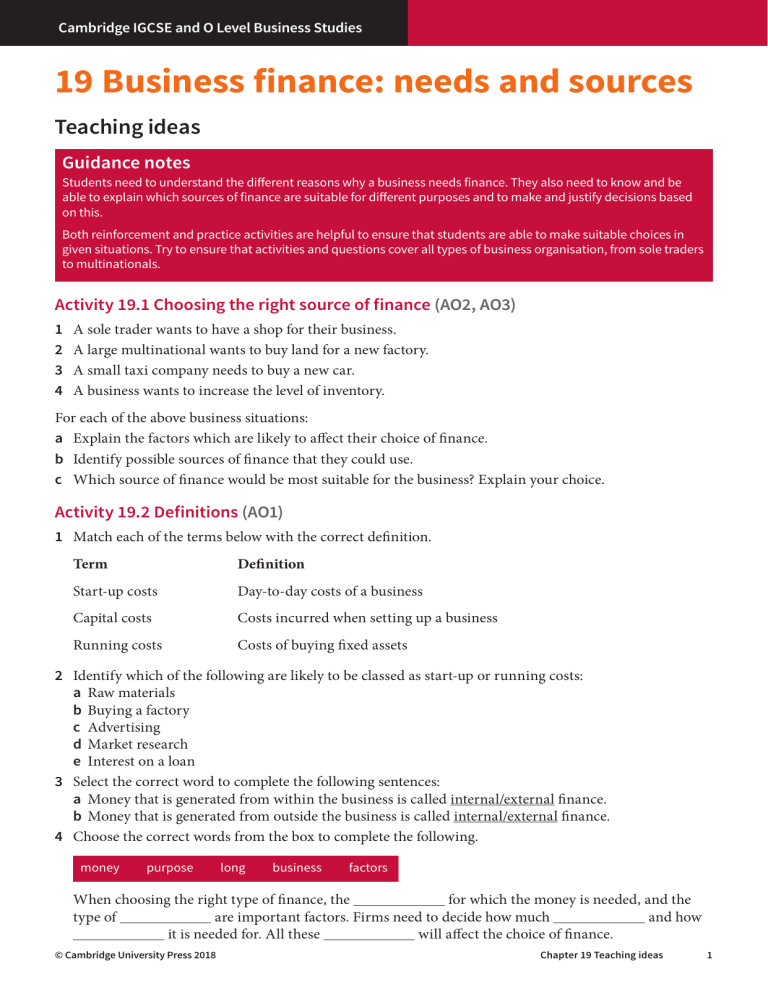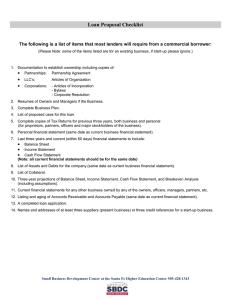
Cambridge IGCSE and O Level Business Studies 19 Business finance: needs and sources Teaching ideas Guidance notes Students need to understand the different reasons why a business needs finance. They also need to know and be able to explain which sources of finance are suitable for different purposes and to make and justify decisions based on this. Both reinforcement and practice activities are helpful to ensure that students are able to make suitable choices in given situations. Try to ensure that activities and questions cover all types of business organisation, from sole traders to multinationals. Activity 19.1 Choosing the right source of finance (AO2, AO3) 1 2 3 4 A sole trader wants to have a shop for their business. A large multinational wants to buy land for a new factory. A small taxi company needs to buy a new car. A business wants to increase the level of inventory. For each of the above business situations: a Explain the factors which are likely to affect their choice of finance. b Identify possible sources of finance that they could use. c Which source of finance would be most suitable for the business? Explain your choice. Activity 19.2 Definitions (AO1) 1 Match each of the terms below with the correct definition. Term Definition Start-up costs Day-to-day costs of a business Capital costs Costs incurred when setting up a business Running costs Costs of buying fixed assets 2 Identify which of the following are likely to be classed as start-up or running costs: a Raw materials b Buying a factory c Advertising d Market research e Interest on a loan 3 Select the correct word to complete the following sentences: a Money that is generated from within the business is called internal/external finance. b Money that is generated from outside the business is called internal/external finance. 4 Choose the correct words from the box to complete the following. money purpose long business factors When choosing the right type of finance, the for which the money is needed, and the type of are important factors. Firms need to decide how much and how it is needed for. All these will affect the choice of finance. © Cambridge University Press 2018 Chapter 19 Teaching ideas 1 Cambridge IGCSE and O Level Business Studies 5 State whether the following sentences are true or false. a A private limited company can raise money on the stock market. b If a business asks for a loan, the bank will always give it the money. c A business will have to pay interest on loans. d A sole trader will have access to fewer sources of funds compared to a limited company. e Trade credit is offered by the customers of a business. 6 Choose the right source of finance for the following situation. Explain your choice. A public limited company has cash-flow problems. Should it: a ask the bank for a long-term loan? b sell shares to raise the money? c ask trade receivables to pay up more quickly? d allow trade receivables more time to pay? Discussion ideas: sources of finance (AO3) ‘Borrowing money is always going to lead to problems for a business!’ In small groups or as a class, do you agree or disagree with this statement? Why? Answers to activities Activity 19.1 1 a Available funds, amount needed, time required, amount of risk, purpose. b Personal loan for a mortgage, borrowing from friends and family, retained profits, leasing. c Student’s own choice – depends how much profit the sole trader has, could be mortgage, retained profit or leasing. Suggest leasing as not likely to have enough retained profit to buy a shop, and loan very risky as personally liable for debt because of unlimited liability. 2 a Amount needed, time required, amount of risk, level of gearing, purpose. b Mortgage, retained profits, long-term bank loan, sale of shares, debentures. c Student’s own choice but a long-term option such as a mortgage or debentures would seem sensible as land is likely to be needed for a long time and it is an expensive purchase. 3 a Amount needed, time required, amount of risk, purpose. b Retained profits, bank loan, leasing. c Student’s own choice but leasing seems a sensible option, as a car would lose value quickly as used a lot to transport passengers around. If the car can’t be used for any other reason, the taxi business is still responsible for repaying a loan. Does the business have enough profit (as small) to meet the cost of a vehicle? Might need profit for emergencies or other plans. 4 a Amount needed, time required, amount of risk, purpose. b Trade credit, overdraft, short-term loan. c Student’s own choice but trade credit is probably best if can obtain good terms from suppliers. Only need to repay suppliers when sell inventory, no interest payment involved. Other options would incur interest payments so increase business costs. Activity 19.2 1 Start-up costs: Costs incurred when setting up a business; Capital costs: Costs of buying fixed assets; Running costs: Day-to-day costs of a business 2 Start-up: b, d; Capital costs: a, c, e. 3 a internal; b external 4 purpose; business; money; long; factors. 5 a True; b False; c True; d True; e False. 6 c – if money is received more quickly from trade receivables then this increases the cash inflow © Cambridge University Press 2018 Chapter 19 Teaching ideas 2



